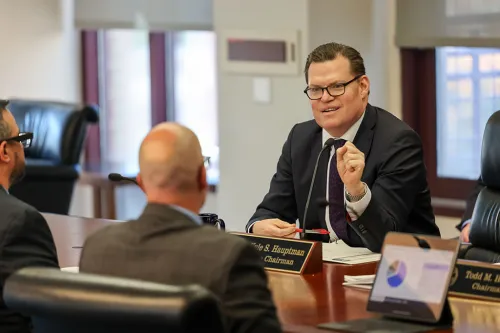NCUA Vice Chairman Kyle S. Hauptman during a meeting of the NCUA Board.
As Prepared for Delivery on October 24, 2024
The last CURE Board Meeting presentation was in June 2023, and the focus was solely on new charter modernization. I appreciate the inclusion of the field-of-membership data today as it gives us a better view into the scope of CURE’s responsibilities.
The new credit union charter process has been a priority for me since my first Board Meeting in December 2020. For over 90 years, forming a credit union in the United States has been the answer to financial inclusion for hundreds of thousands of immigrants, religious groups, factory workers and more.
On June 21, 1934, Franklin Delano Roosevelt signed into law the Federal Credit Union Act in part to address the financial challenges facing rural America following the Great Depression. The newly created Federal Credit Union Division was placed under the Farm Credit Administration. On October 1, 1934 — less than three months later — the first federally chartered credit union was formed in Texas.
So, right or wrong, it was easier to start a credit union because you only dealt with your state government, and you didn’t need to apply for federal deposit insurance – because it didn’t exist yet. The first 2,400 credit unions had zero interaction with anyone in the Washington, DC region.
Things were a lot simpler in 1934 than they are today; today, getting to a completed charter application can take years. While the complexity of financial services has changed, what hasn’t changed is the importance of financial services to people of modest means. Access to financial services and credit can improve the economic trajectory of a family for generations.
Although I appreciate the graph showing the average number of days it takes to go from a completed application to an approved charter, there’s another key metric that I think we should focus on when we do these annual briefings.
Last year, I requested we look back and track the time it takes to get to a successfully completed application. I’d like to acknowledge it can be difficult to pin down the exact ‘start date.’ There are groups we talk to who never wound up moving forward with chartering a credit union. Plus, there are groups we talk to for months, or even years, before they decide to go forward with a de novo application.
I’ve had multiple meetings with groups who spent months, and in some cases years, trying to get CURE to say the application was complete. Much like applying for college, you can neither be admitted or denied admission until the college considers you to have a completed application that includes test scores, transcripts sent, etc. And colleges have an incentive to have lots of applications, so they’d act if a lot of people were getting stuck getting to a completed application. Those people aren’t in their ‘admission rates’ since they’re not in the numerator or denominator.
So, I am pleased to know that we now track the time it takes for a group to formally identify their field of membership until the time they successfully complete their application. This needs to be tracked because that process – getting to a completed application – is where we’ve seen groups give up and they wouldn’t have been included in any of our prior data. This information can help organizing groups plan, as well as assist us in identifying areas of the process that need more streamlining or clarity.
The CAPRIS enhancement system — which was launched in July — is an evolving tool in the field of membership and chartering process. The tool is providing multiple common bond credit unions with a more streamlined process for applying for expansions.
Currently, the NCUA is looking to provide the same system support for new charter applicants. The ability to see more accurately where they are in the chartering process will be a welcome improvement for organizing groups. This tool gives the Board and CURE management visibility into the field of membership and chartering processes, while at the same time measuring progress.
We’ve put the chartering manual online, which has provided much-needed clarity. But our work is not yet done. We’re working on the process here, but the measurement of success will always be new, stable charters.



